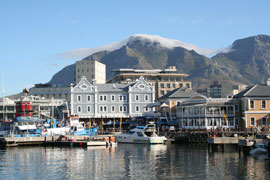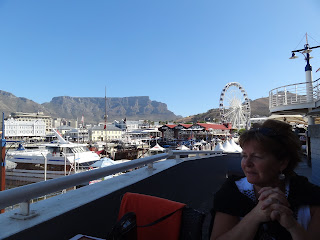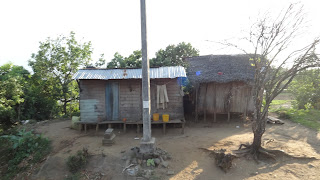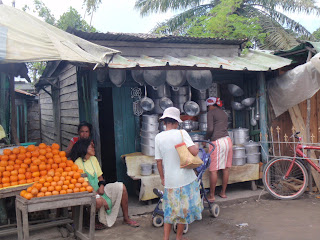Capetown, South Africa
January-February 2012
V & A Waterfront
Prince Alfred second son of Queen Victoria began construction of the harbour in 1860. The first basin was named after himself, the second after his mother, hence the name.
In June 1858 serious winter storms wrecked over 30 vessels, as a consequence, Lloyds of London refused to cover ships wintering in the Bay. On a sunny September 17, 1860 Midshipman HRH Prince Alfred, tipped the first load of stone to start construction of the breakwater for Cape Town’s first harbour
The discovery of gold and diamonds in South Africa meant that the first section of harbour, the Alfred Basin, had to be added to and the Victoria Basin was built. The construction of the two harbour basins took place between 1860 and 1920, and the area is notable for its outstanding heritage building.

In November 1988, Victoria and Alfred Waterfront (Pty) Ltd (“V&AW”) was established as a wholly-owned subsidiary by Transnet Ltd to redevelop the historic docklands around Victoria and Alfred Basins as a mixed-use area with a focus on retail, tourism and residential development, with the continued operation of a working harbour
An absolute beautiful view of Table Top Mountain from the V & A Waterfront. Lots of shopping, resturants and sightseeing.
We took a catamaran out to Robben Island. Robben Island is an island in Table Bay, 6.9 km west of the coast of Bloubergstrand, Capre Town. The name is Dutch for "seal island". Robben Island is roughly oval in shape, 3.3 km long north-south, and 1.9 km wide, with an area of 5 km. It is flat and only a few metres above sea level, as a result of an ancient erosion event. It is of particular note that it was here that Nobel Laureate and former Presidents of South Africa Nelson Mandela and Kgalema Motlanthe, alongside many other political prisoners, spent 27 years imprisoned during the apartheid era. Among those political prisoners was current President of South Africa Jacob Zuma who was imprisoned there for ten years.
TableTop Mountain
The main feature of Table Mountain is the level plateau approximately 3 kilometres from side to side, edged by impressive cliffs. The plateau, flanked by Devil's Peak to the east and by Lion's Head to the west, forms a dramatic backdrop to Cape Town. The highest point on the mountain is 1,086 metres (3,563 ft) above sea level, about 19 metres higher than the cable station at the western end of the plateau.The flat top of the mountain is often covered by clouds, formed when a south-easterly wind is directed up the mountain's slopes into colder air, where the moisture condenses to form the so-called "table cloth" of cloud. Legend attributes this phenomenon to a smoking contest between the Devil and a local pirate called Van Hunks. When the table cloth is seen, it symbolizes the contest.
Table Mountain is at the northern end of a sandstone mountain range that forms the spine of the Cape Peninsula. To the south of the main plateau is a lower part of the range called the Back Table. On the Atlantic coast of the peninsula, the range is known as the Twelve Apostles. The range continues southwards to Cape Point.
I'm not getting to close to the edge-it's a long way down.
It's 6 degrees colder up here, and so windy, you feel it's going to throw you off the edge
Boulders Beach is situated south of Cape Town on the outskirts Of Simons Town, and is famous for being home to a thriving colony of African penguins.- approx 2500
We were surprised to think an Antarctic bird living so successfully in South Africa's temperate climate. The area is protected and is part of the Table Mountain National Park.
We were surprised to think an Antarctic bird living so successfully in South Africa's temperate climate. The area is protected and is part of the Table Mountain National Park.
These penquins have common nicknames, one being the Jackass penguin, as their call resembles a donkey’s bray, another being the Black-
African Penguins are monogamous, and will generally return to the same colony, and often the same nest site. The vast majority pair off and remain together for consecutive breeding seasons. Some pairs have been known to have remained together for over 10 years. Usually two eggs are laid, with an incubation period is about 40 days, with both male and female participating equally in the incubation process.
They didn't like us getting too close to them, although Rick had one screaming at him. (I think he thought Rick was after his girl...)
Took a drive farther out to see the Baboons. Lots of them running around
We were advised to lock our car doors, as they've been know to open the doors, and steal purses, etc. If this happens, let them take it, as they have razor sharp teeth and will rip you apart in a flash
They are basically a nuisance, and are very mischevious
The Big Red Bus, a must! 17 stops around Cape Town. The ClockTower, Convention Center,St. George's Cathedral, South Africa Museum, Mount Nelson Hotel, South Africa Jewish Museum, District area (Apartheid), Castke of Good Hope, Cableway, President Hotel, Wincheter Mansions Hotel, Wine Tour and so many more stops
Grapes, rows and rows
Township in Cape Town in area of Cape Flats, east of Table Mountain. These were created as living areas for non-whites under the old political system of Apartheid. (didn't feel very comfortable walking through there, as Rick and I were the only ones that got off the bus to view the Township)
Following a Mr. Peter Purschke in Cape Town (as the writing on his shirt)
Just a beautiful view on our drive back to the B & B

The Waldon House, where we stayed
Our room in the corner, beautiful place



































 herders. They raise rice in irrigated fields and herd cattle, most of which are zebus. Zebus are ox-like animals that live in the hills. Here in Madagascar they don't measure their wealth by how many cars or fancy houses they have. They measure wealth by how many cattle they own! In this country, there are nearly as many zebus as cattle. They also grow bananas, sweet potatoes, and cassava.
herders. They raise rice in irrigated fields and herd cattle, most of which are zebus. Zebus are ox-like animals that live in the hills. Here in Madagascar they don't measure their wealth by how many cars or fancy houses they have. They measure wealth by how many cattle they own! In this country, there are nearly as many zebus as cattle. They also grow bananas, sweet potatoes, and cassava.






















































